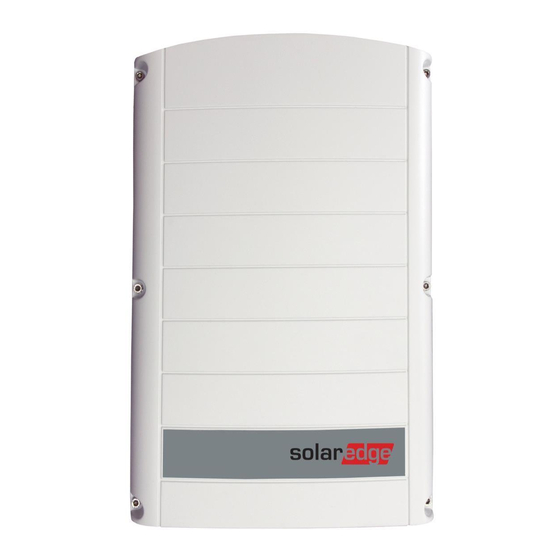
Summarization of Contents
Disclaimers
Important Notice
Copyright and usage terms for the document material.
Handling and Safety Instructions
Safety Symbols Information
Explanation of warning, caution, and note symbols used in the document.
Inverter Interfaces
Description of connectors and components on the inverter.
Important Safety Instructions
Critical warnings and precautions for safe installation and operation.
Chapter 1: Introducing the SolarEdge Power Harvesting System
Power Optimizer
DC-DC converters that maximize power harvesting by performing independent MPPT.
Inverter
Converts DC power from modules to AC power and transmits monitoring data.
Monitoring Platform
Enables monitoring of technical and financial performance of SolarEdge sites.
Installation Procedure
Steps for installing and setting up a new SolarEdge site.
Installation Equipment List
Recommended tools and equipment needed for installation.
Inverter Transport and Storage
Guidelines for transporting and storing the inverter to prevent damage.
Chapter 2: Installing the Power Optimizer
Safety
Notes and warnings applicable when installing power optimizers.
Step 1: Mounting the Power Optimizers
Procedure for securely attaching power optimizers to the support structure.
Step 2: Connecting a PV module to a Power Optimizer
Connecting the PV module's output connectors to the power optimizer's input.
Step 3: Connecting Power Optimizers in Strings
Connecting multiple power optimizers in series to form strings.
Step 4: Verifying Proper Power Optimizer Connection
Checking the voltage and polarity of power optimizer connections.
Chapter 3: Installing the Inverter
Inverter Package Contents
List of items included in the inverter package.
Identifying the Inverter
How to locate the inverter's serial number and electrical ratings.
Mounting the Inverter
Instructions for mounting the inverter vertically or horizontally.
Chapter 4: Connecting the AC and the Strings to the Inverter
Grid Connection Guidelines
Requirements and considerations for connecting to the AC grid.
Connecting the AC Grid to the Inverter
Procedure for connecting the inverter to the AC power source.
Connecting the Strings to the Inverter
Connecting the DC strings from the PV modules to the inverter's DC input.
Selecting a Residual Current Device (RCD)
Information on choosing and using Residual Current Devices for protection.
Chapter 5: Commissioning the Installation
Step 1: Activating the System
Procedure for activating the inverter using the activation card and settings.
Step 2: Pairing Power Optimizers to the Inverter
Logically assigning power optimizers to their respective inverter.
Step 3: Verifying Proper Activation
Checking system status screens to confirm correct activation.
Step 4: Reporting and Monitoring Installation Data
Methods for mapping and reporting installation data for monitoring.
The Monitoring Platform
Overview of the platform for PV performance monitoring and yield assurance.
Creating Logical and Physical Layout using Installation Information
Mapping component locations for system visualization in the monitoring platform.
Chapter 6: User Interface
LCD User Buttons
Description and function of the four buttons used to control the inverter's LCD menus.
Inverter Configuration – Setup Mode
Performing basic system configuration using internal LCD buttons or external light button.
Configuration Menu Options
Hierarchical tree of menu options for configuring inverter settings.
Status Screens - Operational Mode
Displays for inverter status, including AC voltage, DC voltage, and power.
Chapter 7: Setting Up Communication to the Monitoring Platform
Communication Options Overview
Types of communication for transferring information to the monitoring platform.
Creating Network Connections
Steps for establishing Ethernet and RS485 connections for monitoring.
Verifying the Connection
Steps to check if the connection to the monitoring server has been successfully established.
Appendix A: Errors and Troubleshooting
Troubleshooting Communication
Diagnosing and resolving communication issues, especially with Ethernet.
Additional Troubleshooting
General checks for modem, connections, and communication option configuration.
Power Optimizer Troubleshooting
Identifying and resolving issues related to power optimizer pairing and voltage.
Appendix C: Connecting the AC and DC Strings to the DC Safety Unit
Connecting the AC Grid to the Inverter
Procedure for connecting the AC grid to the inverter via the DC Safety Unit.
Connecting the Strings to the DC Safety Unit
Connecting DC strings to the DC input pairs of the switch.
Appendix E: External Fan Maintenance and Replacement
Fan Maintenance
Procedures for cleaning and checking the status of inverter fans.
External Fan Replacement
Steps for replacing a faulty external fan on the inverter.
Appendix F: Replacing and Adding System Components
Replacing an Inverter
Procedure for removing and installing a new inverter unit.
Replacing the DC Safety Unit
Procedure for removing and installing a new DC Safety Unit.
Determining the Circuit Breaker Size
Introduction
Importance of circuit breakers for inverter protection in commercial installations.
Using Transformers in Commercial Three Phase Inverter Installations
Optional use of transformers for connecting to medium voltage power grids.
Determining the Size of an Inverter Circuit Breaker
Explains how to determine the correct circuit breaker size for an inverter.
Technical Specifications - Three Phase Inverters (Europe & APAC)
SE4K - SE12.5K
Technical specifications for SolarEdge three phase inverters models SE4K to SE12.5K.
SE15K - SE33.3K
Technical specifications for SolarEdge three phase inverters models SE15K to SE33.3K.

















Need help?
Do you have a question about the SE5K-RWB and is the answer not in the manual?
Questions and answers